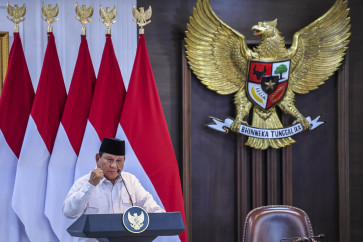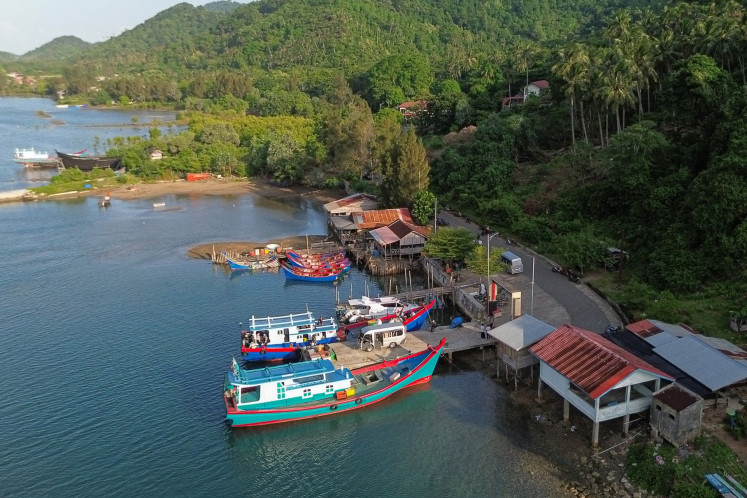Popular Reads
Top Results
Can't find what you're looking for?
View all search resultsPopular Reads
Top Results
Can't find what you're looking for?
View all search resultsFascinated with fashion
A show in Indonesia Fashion Week, which was held for the first time in February
Change text size
Gift Premium Articles
to Anyone
A show in Indonesia Fashion Week, which was held for the first time in February. (JP/P.J.Leo)
Behind its alluring and glitzy image, fashion is an industry that involves many players — designers, models, hair and makeup artists, photographers, stagehands, lighting technicians and celebrities. In order to write a success story, the business requires a combination of creativity, originality, marketing and managerial skills.
However, as the fashion industry grows, more and more people want to pursue their share of the limelight by entering the glamorous world of fashion design.
“Fashion is not only about creating an outfit. Anyone can make a dress. Fashion is more about lifestyle and is influenced by current situations and conditions,” said designer Musa Widyatmodjo, who runs the women’s wear label (M) by Musa.
If so, then what does it take to be a fashion designer?
Prominent fashion designer Luwi Saluadji pointed out the needs of formal and informal education for future and wannabe designers out there.
“Formal education is a vital component ingredient, but it is not enough. You need to have informal education in the real world where you can practice on every aspect of the production process,” said Musa, who took short courses in fashion and now owns the men’s clothing Postour & Co.
Compared to some 30 years ago, when fashion shows for high society and fashion academies were still rare in the country, today, people have easier access to an education in fashion.
Reputable fashion and design schools in the country include the Susan Budihardjo Fashion School, established by noted designer Susan Budihardjo in Jakarta in 1980; LaSalle College International,
an international design college based in Canada; and Esmod Jakarta, based on Esmod International, which has over 160 years of fashion experience.
Fashion designer Ari Seputra suggested young designers gain as much industry experience as possible.
The wannabe designers, he said, could do internship work with
a design or fashion manufacturing company or with experienced designers to get the feel of how customers choose, buy, or even reject products.
“The internship will be worth the time spent in terms of gaining the foundation for moving up to a higher career or starting your own business,” Ari says.
“I worked for [designer] Prajudi as his assistant for 13 years and I felt that it was easier for me to approach a department store or buyer to sell my clothing later on.”
Once in the business, a designer should be able to spot the customers’ preferences — things they are eager to buy; study the market’s profile — from age, income, lifestyles and demography, before setting a target market.
“Designing means you need to draw a concept plan; but to have the concept, you need to do the research,” Musa said.
Luwi said that a designer needs to decide on his or her market.
“If, for instance, you have decided that you will be doing a street-wear clothing line, then it would be suitable for teens, right? Then you need to set the price, which cannot be too expensive considering their limited purchasing power,” said Luwi.
Ari, who runs a women’s clothing line, has started to embrace young customers through his Major Minor brand, sold at The Goods Department at Plaza Indonesia shopping mall in Central Jakarta.
“I see there is a large potential market for youngsters as there are more and more people choosing to dress casually and freely,” Ari said. “Major Minor injects something new, way far from my usual collection. I play with color blocking with asymmetric cutting.”
The prices, he said, are reasonable, ranging from Rp 290,000 (US$30) to Rp 600,000.
He also followed the trends — setting up an online shop to sell his label.
“Today is the era of e-commerce. Everything is done online. So, like it or not, I have to keep up with the trend,” Ari says.
Since the fashion industry needs a high degree of marketing knowledge, Luwi advised independent young designers take a course in marketing.
“You need to learn about matters such as profit, loss and taxes. So you can think of using what kind of fabric that might earn a profit, for instance,” Luwi says.
When he first entered the business in 2002, Luwi found out there was still a huge potential market for tailored men’s clothing, so he opted to focus on designing suits. His concept allows people to make suits and meet the designer in person for consultation.
“During the first six months, I still did both women’s and menswear before I started to shift gear over the next eighth months,” he said.
With the dream of becoming
a brand owner like Giorgio Armani and Dolce & Gabbana, Luwi faced problems in finding an assistant who was willing to stick to his vision.
“Those who come to Postour & Co. are real men. Feminine men, I believe, are not into this manly collection,” said Luwi.
“But it’s not easy to keep and introduce this concept to my assistant. Sometimes, they try to put in little things that tend to bring in the feminine touch.”
Again, sales are crucial — the bottom line of running the fashion business.
“This is not only about staging a glamorous show. This is about selling your products,” Ari said. “Strong sales and knowledge of the business end of the fashion industry are important to a successful career.”
Some designers go for the extravagant looks that might not be worn on the streets. These collections, actually, are part of personal expression and self-accreditation, as well as marketing strategy to seize media and consumer attention.
Other designers are also too busy engulfing themselves in achieving more and more awards, forgetting that they should stay on the ground, paying all the production costs.
“Designers should know that the collection should be wearable and saleable by the time it reaches the stores,” said Luwi.










